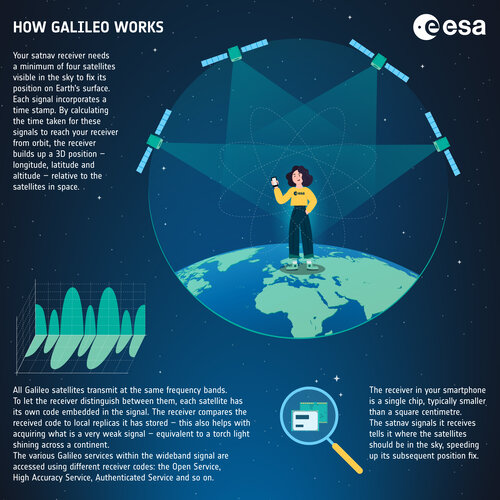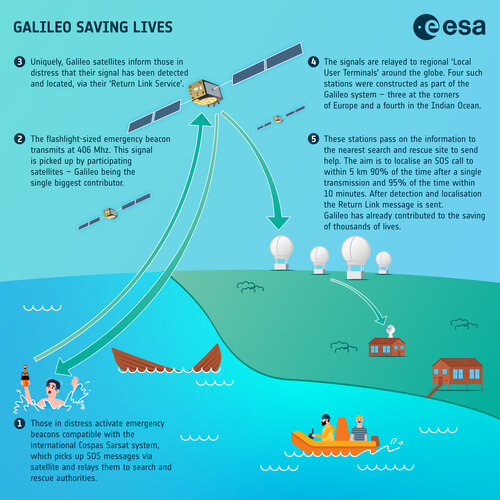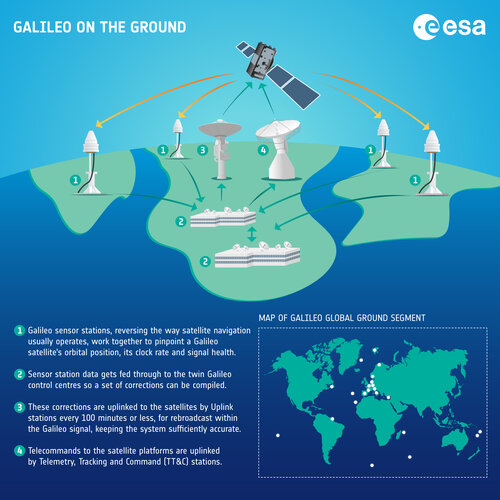Navigation Lab exploring Galileo’s future – and beyond
Would you like to know the future of satellite navigation? Try ESA’s Navigation Laboratory. This is a site where navigation engineers test prototypes of tomorrow's user receivers, using simulated versions of the navigation signals planned for the coming decade, such as set to be transmitted from Galileo’s Second Generation satellites.

José Antonio Garcia Molina, heading ESA’s Radio Navigation Systems and Techniques section, explains: “The Nav Lab has been fundamental for the design and development of the Galileo First Generation and is a key element for ongoing Galileo Second Generation activities. We’re currently developing and evaluating test user receivers for this coming generation of satellites, so we have to simulate the new signals and services they’re being designed for, with terrestrial 6G signals and beyond providing backup coverage.”
Paolo Crosta, heading ESA’s Commercial User Segment and Navigation Systems Validation section, adds: “The same approach was essential with Galileo First Generation. We began testing our first receivers many years in advance of the constellation being in place, because we needed a way of exploring the benefits they would bring once they were in place.”

From ESA’s Navigation Lab to your smartphone
ESA’s Nav Lab is located in a corner of ESA’s ESTEC technical centre in the Netherlands. Its rooftop is a forest of antennas, performing real-time monitoring of all the world’s satnav constellations: not just Europe’s Galileo but the US GPS, China’s Beidou, the Russian Glonass. Even satellites from Japan’s regional Quasi Zenith Satellite System, peeking over from the other side of the world, are trackable.
The Lab has often made satnav history, as the site of the very first Galileo positioning fix on 12 March 2013 and, more recently the initial authenticated Galileo fix and first Galileo High Accuracy fix – validating an approach based on the continuous updating of positioning corrections embedded within the Galileo signal.

Moreover, these days the role of the Nav Lab goes beyond Galileo itself to prepare novel ESA navigation missions, including the new LEO-PNT orbital demonstrator constellation, and the Moonlight programme to extend telecommunications and navigation services to the Moon.
At the same time the team has been monitoring Galileo performance on a systematic basis over the last decade, in parallel with the Galileo Reference Centre next door, operated by the EU Agency for the Space Programme, EUSPA – Galileo's operator.
The team has been able to demonstrate a steady improvement over the years in positioning performance as new satellites, ground stations and refinements were added to the system – from 10-15 m horizontal positioning in 2013 to metre-level accuracy today in challenging environments such as urban landscapes.

Nav Lab on wheels
“We can test for a wide range of user cases,” explains radio frequency engineer Michelangelo Albertazzi. “We have a pair of mobile vans for vehicular testing – typically driving around between here and central Rotterdam – as well as a drone platform and a pedestrian backpack. One of the Lab’s strengths is its versatility.”
The Lab’s monitoring capability also extends across the world, with its Timing and Geodetic Monitoring Facility overseeing a global network of sensor stations for an independent check on Global Navigation Satellite System (GNSS) performance – proper evaluation of satnav services requires authoritative knowledge of the source satellites themselves.

Smartphones finding their way
On the user side, today there are now four billion Galileo-capable smartphones in use, and the Nav Lab played a pivotal role in making that happen.
“Starting back in 2013, in cooperation with what is today EUSPA, we started to perform evaluations of the Galileo-compatibility of mass-market GNSS receivers,” adds Paolo.

“That task extends to this day, shared with the European Union’s Joint Research Centre in Italy. This interaction is valuable for both sides; manufacturers have a way to assess their performance with respect to competitors, while we’ve gained insight into commercial priorities. For example, the importance they place on achieving a fast initial fix, which inspired the recent I/NAV Galileo enhancement.”
Their role gave the Lab a ringside seat for Galileo’s mass-market take-up. The European Commission made Galileo Initial Services available in late 2016, after which progress was rapid. “The very first Galileo-capable phone was Spain’s BQ smartphone – we still have one here. Galileo offered dual frequency signals from the start, which became a big driver, because GPS didn’t have enough dual-frequency satellites by itself to make it worthwhile.”

Using the two frequencies, helps reduce multipath – errors due to reflected signals in built-up areas – as well as compensating for interference form the ionosphere, the electrically active layer of Earth’s atmosphere. Following on from numerous Android models, Apple released their own first dual-frequency GNSS smartphones, the iPhone 14 Pro and Pro Max, last autumn.
Reflecting the Nav Lab’s pivotal role in European navigation, an expansion plan is now underway, set to double its overall area.

About Galileo
Galileo is currently the world’s most precise satellite navigation system, serving close to four billion users around the globe since entering Initial Services. All smartphones sold in the European Single Market are now guaranteed Galileo-enabled. In addition, Galileo is making a difference across the fields of rail, maritime, agriculture, financial timing services and rescue operations.
Galileo is a flagship programmes of the EU Space Programme, managed and funded by the European Union. Since its inception, ESA leads the design and development of the space and ground systems, as well as procuring launches. EUSPA (the EU Agency for the Space Programme) acts as the service provider of Galileo, overseeing the market and application needs and closing the loop with users.
For more info about Galileo: https://www.usegalileo.eu/EN/.


Access the video














 Germany
Germany
 Austria
Austria
 Belgium
Belgium
 Denmark
Denmark
 Spain
Spain
 Estonia
Estonia
 Finland
Finland
 France
France
 Greece
Greece
 Hungary
Hungary
 Ireland
Ireland
 Italy
Italy
 Luxembourg
Luxembourg
 Norway
Norway
 The Netherlands
The Netherlands
 Poland
Poland
 Portugal
Portugal
 Czechia
Czechia
 Romania
Romania
 United Kingdom
United Kingdom
 Slovenia
Slovenia
 Sweden
Sweden
 Switzerland
Switzerland


































